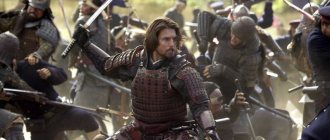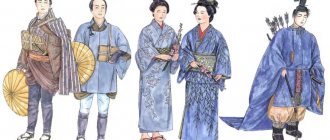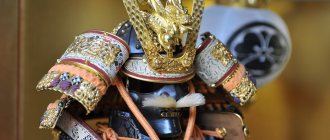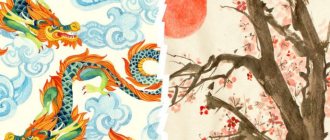Principles of Bushido
The name Bushido was not used until the 16th century, but the idea of a code developed from the Kamakura period (1192-1333). At that time, the Minamoto family founded Japan's first military government (bakufu), headed by a hereditary leader, the shogun. The content of the Bushido code gradually changed as the samurai class came under the influence of Zen Buddhism and Confucian thought, but its only constant ideal was the fighting spirit, including athletic and military skills, as well as fearlessness in battle. Frugal living, kindness, filial piety, honesty and personal honor were also highly valued. However, the highest duty of a samurai was duty to his master, even if it might cause suffering to his parents.
Bushido believes that man and the universe were created similar in both spirit and ethics. Along with these virtues, Bushido has the greatest respect for justice, benevolence, love, sincerity, honesty and self-control. Justice is one of the main factors of the samurai code. Vile deeds and unjust actions are considered base and inhumane. Love and benevolence were the highest virtues and princely deeds. Samurai adhered to a certain etiquette both in everyday life and in war. Sincerity and honesty were valued no less than their lives. Bushi no ippun (武士の一分), or "honor of the samurai", was a pact of complete loyalty and trust. Such contracts did not require a written pledge: this was considered beneath the dignity of a warrior. The samurai also needed self-control and stoicism in order to be fully respected.
MIYAMOTO MUSASHI, JAPAN'S GREATEST SWORDMAN
Read online “Bushido. Samurai Code of Honor"
A. A. Maslov
Bushido. Samurai Code of Honor
Preface
Once, one of the rich daimyo sent a messenger to the famous warrior Hosokawa San-say (XVII century), famous for his delicate taste in making armor. The envoy had to order a particularly elegant combat helmet from Hosokawa, and one that would amaze even samurai experienced in these matters with its appearance. Imagine the surprise of the visitor when Hosokawa proposed making a traditional “horned” helmet by making horns from wood! The samurai was amazed by the choice of material - after all, the horns usually withstand heavy blows from the sword, and, if necessary, pierce the chest armor of the enemy. In response to perplexed questions, Sansai calmly explained: let the horns break, as long as they do not distract the warrior’s attention.
But every time after a battle you will have to repair such a helmet for a long time, but what if you need to go into battle again the next day? And here Sansai essentially defined the way of the samurai: a warrior should not hope to live another day. Moreover, “if a warrior’s thoughts are occupied only with how not to damage the ornament on his helmet, how can he save his life? The top of the helmet, broken in battle, looks truly magnificent. But if you lose your life, you will never get it back.”
Hearing this, the messenger left without asking any more questions.
Here we are talking about a special moral ideal of the Japanese military tradition - the famous code of samurai honor Bushido, or “Way of the Warrior”. There is probably not a single book about Japanese martial arts, ancient or modern, that does not mention him. But no matter how different the interpretations of Bushido may be, they all agree on one thing - it is Bushido that represents the very soul of samurai, its inner essence.
Soul of Japan
The path of the sage - read
Heaven and imitate antiquity.
Antiquity and modernity penetrate each other, so former sages pass on patterns of their behavior to subsequent generations.
Dong Zhongshu, Chinese philosopher (2nd century BC)
“Bushido” - ideal and reality
Ways of the Warrior
Some things are so shameful that they cannot be honest, such as revenge for an insult, wishing harm to a person.
Such things should be discarded, no matter what benefit or pain they may be associated with. Erasmus of Rotterdam.
Weapons of the Christian warrior “Don’t be late to take the path of the warrior”
The definition of Bushido as a “code of samurai honor” is not entirely correct. There was no code as such (more precisely, there were dozens of independent collections of rules of samurai behavior), we can only talk about a certain global ideal of samurai life, a special mood of a warrior. And this ideal itself, largely fickle and changeable, was formed over centuries.
.
When did this doctrine, “The Way of the Warrior,” begin to take shape? Naturally, it is impossible to give an exact date, but we still know some starting points. In 792, a system of military education for young men, called “Kondei” (“Reliable Youth”), was officially introduced in Japan. People from noble families were selected for special schools, where they were equally taught to operate with a sword and a brush, that is, they tried to implement the eternal ideal of Japanese culture - “Military and civil merge into one” (“bunbo ichi”). This idea has been discussed for a long time. Even during the reign of Emperor Kammu in 782, at the imperial residence in Kyoto, construction began on a monumental building for a special school for training professional warriors from among young kuge, i.e. aristocrats. This is how the famous Butokuden - “Hall of Military Virtues” arose, which has been preserved (naturally, in a reconstructed form) to this day. Having completed a full course of military sciences, the young men were sent as officers to the troops.
Soon the opportunity presented itself to test the effectiveness of the reformed army. Her opponent was not an external enemy, but the indigenous people of the Japanese Islands - the Ainu. As a result of battles with the samurai, the Ainu, despite their desperate courage and considerable military valor, were pushed back to the northernmost territory of Japan - the island of Hokkaido.
Gradually, improving the art of war (constant training in sword fighting, spear fighting, and archery) becomes essentially the only activity to which warriors devote their time. And after this comes the awareness of the special status of a warrior - in the eyes of his fellow tribesmen, he becomes the bearer of the highest truth of the martial arts. Thus, a special ideology emerged among the warriors, reflecting the consciousness of their almost mystical exclusivity. It was no longer enough for Busya to feel like “superman”; they claimed to resolve issues far beyond the scope of martial arts (administration of territories, organization of agriculture and, finally, power in the country). It might seem that the hereditary aristocracy, which traced its genealogy almost from gods and spirits, would be unlikely to so easily give up power to desperate but illiterate warriors. However, the terrible battles that unfolded in Japan in the 12th – 13th centuries. , showed the full power of influence of the poorly educated, but surprisingly active layer of bushi warriors, opposed to the hereditary aristocracy of the kuge. The political and cultural situation turned out to be critical: the kuge, who had ruled the state for centuries, showed themselves simply not adapted to active life in an era of continuous wars...
Ethics
Bushido was a strict code that demanded loyalty, devotion and honor until death. In bushido, if a samurai failed to defend his honor, he could regain it by committing seppuku (ritual suicide).
Bushido is based on the following principles:
- Loyalty and devotion (忠義【ちゅうぎ】chūgi): to one's feudal master.
- Morality and integrity (義【ぎ】gi)
- Honor (名誉【めいよ】meiyo)
- Respect and Gratitude (礼【れい】rei)
- Honesty and Loyalty (誠(P); 実【まこと】Makoto)
- Courage and Courage (勇【ゆう】yū)
- Friendliness and Humanity (仁【じん (P); にん】yū)
- Filial Piety (孝【こう; きょう】kō, kyō)
- Respect for the Elderly (悌【てい】tei)
- Wisdom (知; 智【ち】chi)
Knights and Samurai: Comparison of Feudal Structures in Japan and Europe
The first seven principles form the basis of the Japanese warrior code, and the other three can be considered as related virtues. In general, they are akin to the concept of chivalry in medieval Europe. The idea of bushido was first mentioned in 8th-century literature and became widespread as a philosophical concept during the Kamakura and Muromachi periods (11th to 16th centuries), when the basic conduct of a warrior was called "the way of the horse and the bow" (弓馬の道 kyūba no michi). The warrior ideal was embodied in the poetry and literature of the period, such as the Haike Monogatari, which depicts the Genpei War (源平合戦 Genpei Kassen) between the Minamoto (源) and Taira (平氏) clans.
Edo period
The Edo period ushered in an unprecedented peaceful chapter in Japanese history. The samurai, while technically military, took over the administration and protection of their fiefs throughout Japan (on behalf of the Tokugawa regime). Bushido literature of the time contains many thoughts of samurai searching for their place in life, their attempts to apply martial principles and experience in times of peace, as well as reflections on the long history of wars and disasters on this land.
Yamaga Soko (山鹿素行, 1622–1685), philosopher, strategist, and staunch Confucian, became the leading theorist on samurai behavior. Focusing on a more general form of bushido based on pure Confucianism and emperor worship, which not only the samurai class but also the common populace had to follow. The samurai was equated with the Confucian “impeccable gentleman.” Children were taught that their main function was to serve as an example of virtue to the lower classes.
Obedience to authority was emphasized, but duty came first, even if this entailed a violation of statutory law . The extent to which debt crowded out everything else is perhaps best illustrated in the early 18th century the 47 ronin The samurai, who had lost their master (rōnin) after their master was treacherously killed, avenged the death of their master, and after this all were ordered to commit seppuku.
Storming the castle. 47 Ronin.
Yamaga thought of the samurai as "warrior-sages" and focused his writings on refining this "transcendental ideal", justifying their development from a purely military aristocracy into a category of political and intellectual leaders. However, he soon quarreled with the Tokugawa bakufu, burned his works and was expelled.
Who is Ronin
A terrible man, a ghost who haunts the dreams of official officials and makes the most cowardly of them wake up in a cold sweat; a warrior released into free swimming, aimlessly wandering here and there like a wave of the sea - all this is a ronin, which literally means “wave man”.
There were a great many Ronins, according to some authors, about 400 thousand, but all of them can be divided into three large groups: 1. rich vassals who voluntarily left their posts; 2. “fired” for some “minor act” by their employers. The ronin who belonged to this group usually tried to earn forgiveness and atone for their guilt so that they would be allowed to return to their former positions; 3. This group included ronin, located at the very bottom and expelled from the clan for offenses and misdeeds or greed. Such ronins did not advertise the names of their former masters.
Nitobe Inazou
After the Meiji Restoration, bushido advocates focused on the central role of the Emperor and the devotion expected of his subjects. The government and military turned Bushido into a propaganda tool, adapting it to their political needs.
Nitobe Inazō (新渡戸稲造, 1862–1933) was a Japanese agricultural economist, writer, educator, diplomat, politician, and Christian. He advocated the development of spiritual ties between Japan and foreign countries. He became famous in the West for his book Bushido, the Soul of Japan. Samurai Code of Honor" (1900).
This unique book is the most complete and understandable description of not only the martial art that originated in feudal Japan, but also an explanation of the principles of education and the formation of the Japanese national character. All these principles, be it in everyday life, business or relationships with people, can be successfully followed now - after all, the concepts of duty, honor, patriotism and loyalty never become outdated.
He originally wrote his work in English to introduce Western readers to Japan.
But there is another opinion that “ this (the Bushido code) is a modern product .” B. Hall Chamberlain (18 October 1850 – 15 February 1935), a leading British scholar of Japanese studies, stated: Bushido as an institution or set of rules never existed. The information given about it was fabricated mainly for foreign consumption... The word itself did not appear in any dictionary, either native or foreign, until 1900... Bushido was unknown about ten years ago.
Three legends of Lake Biwa. Ancient tales and folklore of Japan.
Views: 1,417
Share link:
- Tweet
- Share posts on Tumblr
- Telegram
- More
- by email
- Seal
Liked this:
Like










